
Duke Nukem 3D is a first-person shooter video game developed by 3D Realms. It is a sequel to the platform games Duke Nukem and Duke Nukem II, published by 3D Realms.

Hexen: Beyond Heretic is a fantasy first-person shooter video game developed by Raven Software and published by id Software distributed through GT Interactive on October 30, 1995. It is the sequel to 1994's Heretic, and the second game in Raven Software's "Serpent Riders" trilogy, which culminated with Hexen II. The title comes from the German noun Hexen, which means "witches", and/or the verb hexen, which means "to cast a spell". Game producer John Romero stated that a third, unreleased game in this series was to be called Hecatomb.

Quake is a first-person shooter game developed by id Software and published by GT Interactive. The first game in the Quake series, it was originally released for MS-DOS, Microsoft Windows, and Linux in 1996, followed by Mac OS and Sega Saturn in 1997 and Nintendo 64 in 1998.
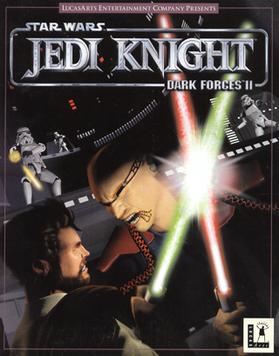
Star Wars Jedi Knight: Dark Forces II is a 1997 first-person shooter video game developed and published by LucasArts for Windows. It is the sequel to 1995's Star Wars: Dark Forces, and the second installment in the Star Wars: Jedi Knight series. The story, set in the fictional Star Wars expanded universe one year after the film Return of the Jedi, follows returning protagonist Kyle Katarn, a mercenary working for the New Republic, who discovers his connection to the Force and "The Valley of the Jedi", an ancient source of power. With his father having been murdered years prior by the Dark Jedi Jerec and his followers over the Valley's location, Katarn embarks on a quest to confront his father's killers and find the Valley before they do.
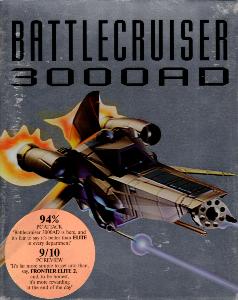
Battlecruiser 3000AD is a space trading and combat simulator video game developed by 3000 AD. It was designed by 3000 AD president and lead developer Derek Smart as the studio's first project.

Blood is a 3D first-person shooter video game developed by Monolith Productions and published by GT Interactive and developed using Ken Silverman’s Build engine. The shareware version was released for MS-DOS on March 7, 1997, while the full version was later released on May 21 in North America, and June 20 in Europe.

Starsiege: Tribes is a first-person shooter video game. It is the first of the Tribes video game series and follows the story from Metaltech: Earthsiege and Starsiege. It was developed by Dynamix and published by Sierra On-Line in 1998. An expansion pack, Tribes Extreme, was cancelled; it was supposed to add single-player missions, multiplayer maps, and bot AI.
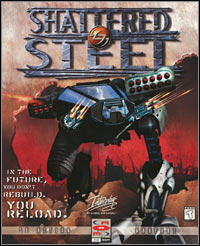
Shattered Steel is a mech simulation game developed by BioWare and published by Interplay Productions for MS-DOS in 1996. It was later ported to Mac OS by now-defunct Logicware. It is notable for the deformable terrain effects, and for being BioWare's first developed game.

Syndicate Wars is an isometric real-time tactical and strategic game, developed by Bullfrog Productions and published by Electronic Arts. It was released for DOS in 1996 and for the PlayStation in 1997. It is the second video game title in the Syndicate series, retaining the core gameplay and perspective of the original Syndicate, but with a setting 95 years further into the future.

Monster Truck Madness is a racing video game developed by Terminal Reality and published by Microsoft. It was released in North America on September 9, 1996. The game has twelve monster trucks and tasks the player with beating computer opponents. Checkpoints, multiple hidden shortcuts, and interactable objects commonly appear in the tracks. In the garage, the player modifies the truck to account for terrain surfaces. Online multiplayer is accessed with a modem, a local area network (LAN), or TCP/IP.
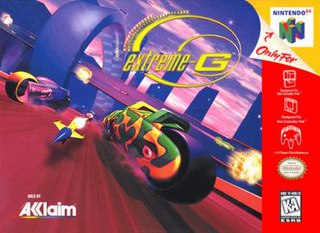
Extreme-G is a futuristic racing video game developed by Probe Entertainment and published by Acclaim Entertainment, featuring an original trance soundtrack. It was released for the Nintendo 64 in 1997, with a Japan release on May 29, 1998. Despite the competitive landscape of Nintendo 64 racing games, Extreme-G received moderately positive reviews and achieved commercial success. A sequel, Extreme-G 2, was launched in 1998, followed by two additional titles: Extreme-G 3 (2001) and XGRA: Extreme-G Racing Association (2003). In 2024, the game was re-released through the Nintendo Switch Online + Expansion Pack by Throwback Entertainment, which acquired the rights to the game in 2006.

Worms: Open Warfare is a 2D artillery tactical game. It was developed by Team17 and published by THQ for the PlayStation Portable and Nintendo DS. It is the first game in the Worms series to be released for seventh generation handheld consoles and marked the series' return to its original 2D gameplay style.

Worms is a 2D artillery tactical video game developed by Team17 and released in 1995. It is the first game in the Worms series of video games. It is a turn based game where a player controls a team of worms against other teams of worms that are controlled by a computer or human opponent. The aim is to use various weapons to kill the worms on the other teams and have the last surviving worm(s).

Skynet is a 1996 first-person shooter video game developed by Bethesda Softworks based on the Terminator franchise. It was intended as an expansion pack for the predecessor The Terminator: Future Shock, but was adapted into a standalone product.

Hind is a combat flight simulation game released by Digital Integration in 1996 for MS-DOS compatible operating systems and Microsoft Windows. It is the successor to Apache.

T-MEK is a two-player, sit-down, virtual reality fighting arcade game developed and published by Atari Games in 1994.

Independence Day is a combat flight simulator video game based on the 1996 film of the same name. The game was developed by Radical Entertainment and published by Fox Interactive in North America and Electronic Arts internationally for Microsoft Windows, PlayStation and Sega Saturn.

NanoTek Warrior is a tube shooter game developed by American studio Tetragon Inc. and released by Virgin Interactive in 1997.
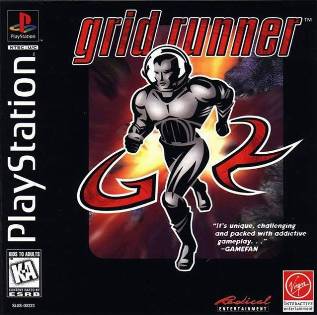
Grid Runner is an action game developed by Radical Entertainment and published by Virgin Interactive Entertainment for the Sega Saturn, PlayStation, and Microsoft Windows in 1996. It is frequently described as a cross between tag and capture the flag, but the playing field is a maze-like grid which the players can manipulate to an extent. Players can either compete against each other in one-on-one matches or take on a series of AI opponents in the game's story mode. Grid Runner was first announced under the title "Eurit".
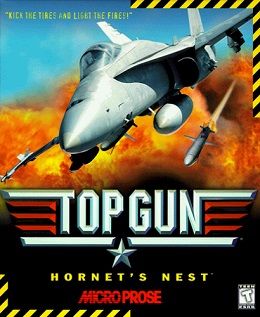
Top Gun: Hornet's Nest is a 1998 combat flight simulation game developed by Zipper Interactive and published by MicroProse for Microsoft Windows. It is loosely based on the 1986 film Top Gun, and is a sequel to the 1996 game Top Gun: Fire at Will. The game was criticized for its lack of realism and its flight physics.




















